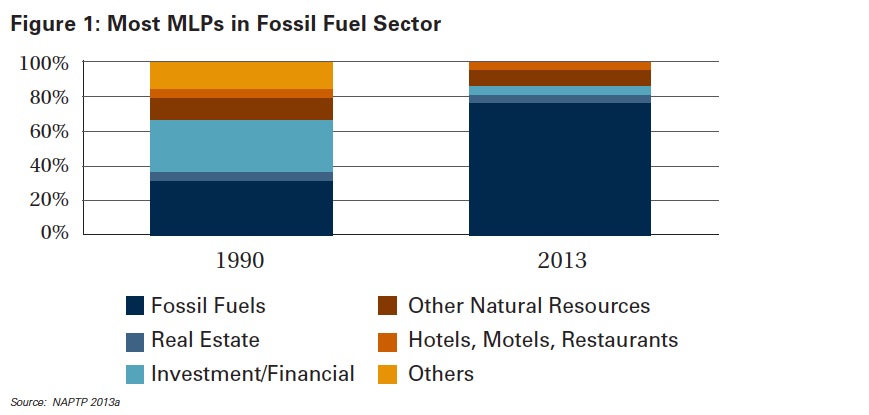OIL CHANGE INTERNATIONAL
Executive Summary
 Fossil fuel firms – predominantly oil and gas – dominate a special category of business tax structures called “master limited partnerships,” or MLPs. The sector is the primary beneficiary of a narrow exemption created by Congress in 1987 when tax-exempt treatment of publicly-traded partnerships (PTPs) was largely ended.
Fossil fuel firms – predominantly oil and gas – dominate a special category of business tax structures called “master limited partnerships,” or MLPs. The sector is the primary beneficiary of a narrow exemption created by Congress in 1987 when tax-exempt treatment of publicly-traded partnerships (PTPs) was largely ended.
MLPs are able to avoid corporate level income taxes entirely, as well as distribute cash to owners on a tax-deferred basis. While beneficial to MLPs, the tax-favored treatment disadvantages market competitors in the electric power, heating, and transport fuel sectors, including renewable energy and energy efficiency providers. Most federal assessments of energy subsidies have excluded MLPs entirely; where official estimates of revenue losses have been done, these numbers appear to be significantly understating the subsidy magnitude. Key findings from this review include:
- MLP tax expenditures are part of a broader set of government subsidies that continue to underwrite activities contributing to climate change. These policies not only have large fiscal costs, but also work counter to the country’s environmental goals and our national interest.
- Fossil fuel MLPs are growing quickly. The market capitalization of fossil fuel MLPs reached an estimated $385 billion by the end of March 2013, up from less than $14 billion in 2000. Related tax subsidies have been as high as $4 billion annually in recent years.
- Fossil fuel activities continue to dominate MLPs, both in number of firms and share of total market capitalization. As of the end of last year, 77 percent of MLPs were in the oil, gas, and coal sectors based on data collected by the National Association of Publicly Traded Partnerships (NAPTP), the main industry trade association. Firms in the fossil fuel sectors comprised 79 percent of total MLP market capitalization, though this figure is likely a bit low. Firms classified in other sectors also include some oil and gas-related businesses, including fracking sand and fossil fuel investments held by publicly-traded private equity firms such as Blackstone.
- Government estimates of tax expenditures from energy-related MLPs are too low. Tax expenditures related to MLPs have been understated in recent years, and appear to be growing rapidly. Using a variety of estimation approaches, we estimate that tax preferences for fossil fuel MLPs cost Partnershipsthe Treasury as much as $13 billion over the 2009-12 period, more than six times the official estimates (see Table 5).
- MLP tax breaks are among the largest subsidies to fossil fuels. Although most government reviews of energy subsidies have not even included MLP-related tax expenditures, our estimates suggest this subsidy is among the top five largest fiscal subsidies to the fossil fuel sector and the largest single tax break to the sector.
- Growing share of production cycle for oil, gas, and coal can be organized as a tax-favored MLP. Financial innovation and IRS private letter rulings have expanded the fossil fuel market segments able to legally and successfully operate as tax-favored MLPs. Recent innovations have even established a precedent by which MLPs have successfully acquired taxable corporations, taking them off the corporate tax role in the process.
- Even in well-established market segments, there is a large overhang of fossil fuel assets poised to exit the corporate income tax system through conversion to MLPs. Less than 20 percent of total assets in the refiners, exploration and production, oil services, and coal sectors are presently held in a tax-favored MLP format (see Table 6). Even in the MLP-intensive midstream segment of the oil and gas market, conventional (taxable) corporate forms continue to own more than half of the assets. In all of these sectors, there is a huge pool of assets that multiple investment firms anticipate will convert to MLPs in coming years.
- Despite a booming oil and gas sector, corporate income tax collections by the U.S. Treasury may remain flat or decline. Broader MLP-eligibility and growing capabilities and interest in converting assets from C-corporations to MLPs dampen corporate income tax collections from the oil and gas sector. Despite a boom so large that the United States is rapidly climbing towards becoming the world’s largest producer of both oil and natural gas, the Treasury may see only limited income tax benefits.
- Proposed expansion of MLP eligibility to renewables risks disproportionate benefits flowing instead to the fossil fuel sector. Current efforts to expand MLP treatment to renewables (The Master Limited Partnerships Parity Act) are not necessarily a panacea for alternative energy. The expansion will reduce the likelihood that MLP’s tax-exempt treatment will be ended for fossil fuel producers, allowing the rapid growth of tax-exempt fossil fuel MLPs to continue unchecked. This legislation also would open MLP-eligibility to power generation for the first time,creating risks that this treatment will be extended from the current proposed set of recipients (biomass, solar, wind, geothermal) to all forms of power generation in coming years. This would disadvantage energy conservation, offset hoped for gains from the expansion in renewable sectors, and trigger very large tax losses to Treasury.
- The MLP loophole should be closed; MLPs should be taxed as conventional corporations, not extended to new uses. This strategy, continuing what the United States started in 1986, would eliminate large and growing subsidies to fossil fuels.
Download full report (PDF): Too Big to Ignore
About Oil Change International
priceofoil.org
Oil Change International is a research, communication, and advocacy organization focused on exposing the true costs of fossil fuels and facilitating the coming transition towards clean energy. We focus on the fossil fuel industry because we view the production and consumption of oil, gas and coal as sources of global warming, human rights abuses, war, national security concerns, corporate globalization, and increased inequality. We also see fossil fuel industry’s interests behind every major barrier to a clean energy transition.







 RSS Feed
RSS Feed